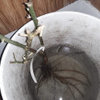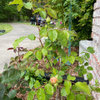Julia Child's thorniness
carolinamary
14 years ago
Related Stories

LIFEButter Up Your Kitchen With Julia Child's Wisdom
Your kitchen will serve you more fully and beautifully when you borrow from these keen insights
Full Story
KITCHEN DESIGNJulia Child's Childhood Kitchen Gets a Makeover
Drop in on the California kitchen that may have influenced a legend, now remodeled for a next-generation cooking and entertaining enthusiast
Full Story
PRODUCT PICKSGuest Picks: Beautiful Wallpaper to Grow With a Child
These lighthearted papers will last from babyhood to beyond the teenage years — and they appeal to grown-up eyes too
Full Story
KITCHEN STORAGEBoost Your Kitchen Storage With Pegboard on a Wall
Julia Child knew it: This budget-friendly material is a winner for wall organization
Full Story
KITCHEN COUNTERTOPS10 Top Backsplashes to Pair With Soapstone Countertops
Simplify your decision-making process by checking out how these styles work with soapstone
Full Story
SHOP HOUZZShop Houzz: Up to 70% Off French Country Kitchen Essentials
French cookware plus charming serveware and decor, all on sale
Full Story0

DECORATING GUIDESSo Your Style Is: French Country
With an artful balance between earthy and chic, French country style infuses a home with incomparable warmth and welcome
Full Story
HOUZZ TV FAVORITESHouzz TV: A New England Farmhouse Explodes With Color
Creativity and color burst from every corner in this unique 18th-century Massachusetts home for an artist and her family
Full Story
DESIGNER SHOWCASESSan Francisco Decorator Showcase: Happy Days Are Here Again
Creative ideas, bold colors and inventive materials abound under one (very large) roof
Full StorySponsored
Industry Leading Interior Designers & Decorators in Franklin County
More Discussions












hoovb zone 9 sunset 23
carolinamaryOriginal Author
Related Professionals
Eden Prairie Landscape Architects & Landscape Designers · Waterbury Landscape Contractors · Battle Ground Landscape Contractors · Davidson Landscape Contractors · Edinburg Landscape Contractors · Fort Payne Landscape Contractors · Hendersonville Landscape Contractors · Homewood Landscape Contractors · Melrose Landscape Contractors · Palatine Landscape Contractors · Pikesville Landscape Contractors · Pleasant Hill Landscape Contractors · Richmond Landscape Contractors · Waltham Landscape Contractors · Quartz Hill Landscape Contractorshosenemesis
anntn6b
hoovb zone 9 sunset 23
User
carolinamaryOriginal Author
serenasyh
serenasyh
carolinamaryOriginal Author
serenasyh
anntn6b
york_rose